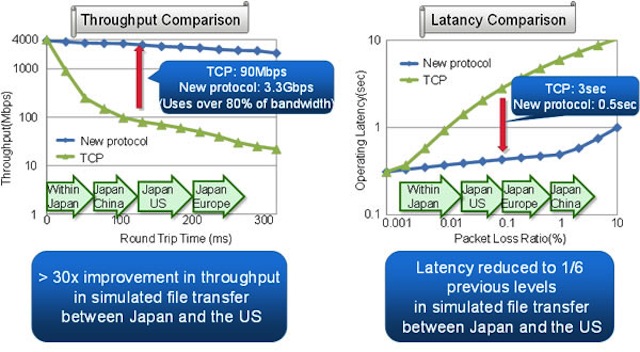Sunday, 24 February 2013
Fujitsu develops new data transfer protocol that is 30 times faster than TCP
Posted By: Static GSM - Sunday, February 24, 2013There are two main data transfer protocols — Transmission Control Protocol (TCP) and User Datagram Protocol (UDP). If you only had to know one fact about each protocol, it’s that TCP is slower because it takes time to check for errors, and UDP is faster because it doesn’t check for errors as much. Obviously, as shown by both protocols, having to vigorously check for errors limits the speed of a transfer protocol, but Fujitsu has announced that it has found a way to add error-checking into a UDP-like protocol and keep the higher speed.
At a basic level, TCP delivers data through an ordered, verified delivery — imagine a single-file line of people slowly entering a building, then a bouncer checking off a list, verifying that the people indeed entered. The line will move at a steady pace, but only one person will enter the building at a time. With basic regards to UDP, imagine that same line of people standing outside of the building, but the bouncer doesn’t check people off the list as they enter. Sure, most of the people want to get into the building anyway, but if one doesn’t make it, the bouncer doesn’t really care and keeps the line moving regardless, rather than going to look for the missing person. Basically, Fujitsu’s new protocol hired a bouncer that goes out and finds that missing person much more quickly than the previous bouncer would have, if he even cared to.
Fujitsu claims that the currently unnamed transfer protocol offers speeds of up to 30 times those provided by standard TCP, citing the protocol to reduce virtual desktop operating system latency to under 1/6 of the latency previously experienced. The protocol is software-based, and works not only by employing a more efficient method of resending data lost in the transfer, but employing a more efficient method of checking to see if data was lost in the first place. The new protocol will also perform efficient real-time measurements of bandwidth, allocating and restricting the transfer of data when necessary. Along with that, Fujitsu claims the new protocol speeds up TCP methods from a base level, inherently speeding up TCP in general.
Because of the general speed performance and enhanced data loss prevention — but especially the remote desktop latency reduction — the new protocol is positioned to greatly aid long distance collaborative projects. Fujitsu also claims the new protocol can enhance everyday user tasks, such as speed up file transfers and web browsing. Thanks to the software-only installation, the protocol should be easy enough to get out into the open once it is ready for distribution, as hardware shouldn’t have to be replaced to receive it.
Without actual public tests, we wouldn’t be able to tell if Fujitsu’s claims of a 1/6 reduction in remote desktop latency and data transfer speed boost of up to 30 times is actually achievable, but the company most likely wouldn’t be attempting to develop a new protocol if it didn’t improve upon something. Fujitsu hasn’t said exactly how its new protocol works aside from the general descriptions provided above, but then if the company divulged its secret, it wouldn’t be able to commercialize the new protocol, which it is planning on doing sometime later this year.
About Static GSM

Organic Theme is officially developed by Templatezy Team. We published High quality Blogger Templates with Awesome Design for blogspot lovers.The very first Blogger Templates Company where you will find Responsive Design Templates.
Subscribe to:
Post Comments (Atom)








0 comments:
Post a Comment